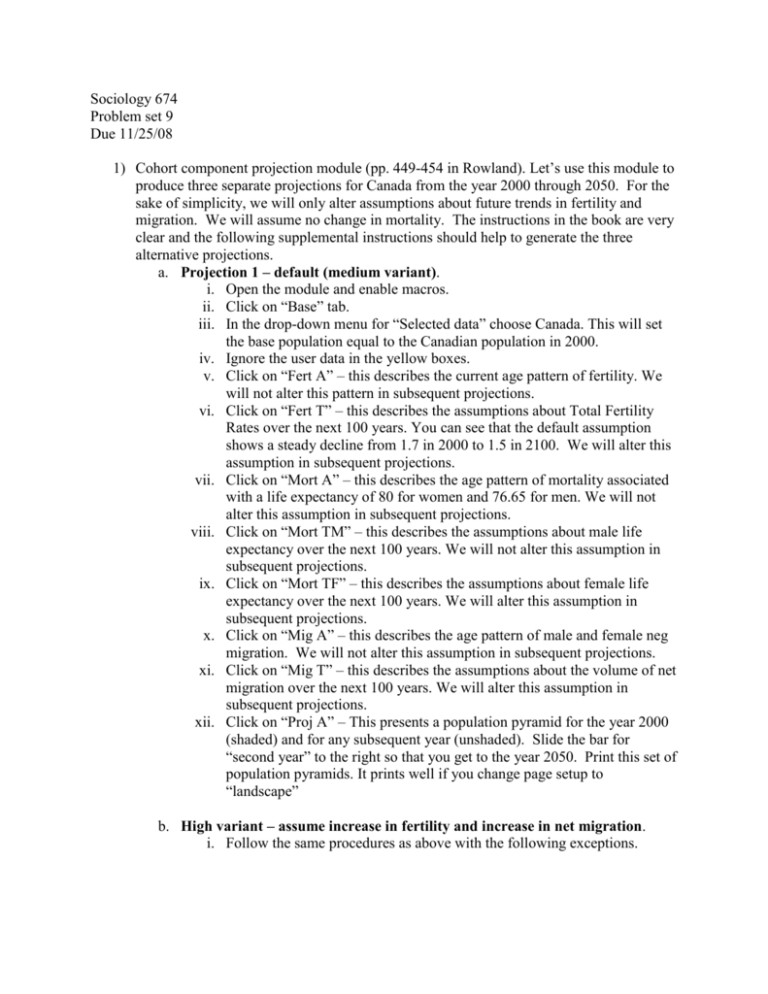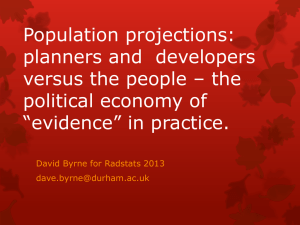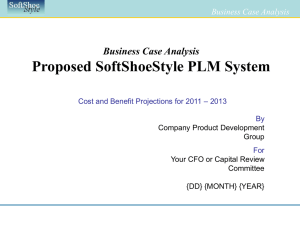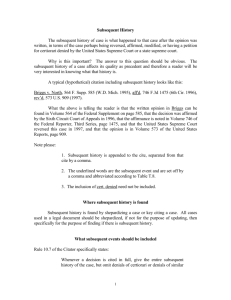Problem set 9 due
advertisement

Sociology 674 Problem set 9 Due 11/25/08 1) Cohort component projection module (pp. 449-454 in Rowland). Let’s use this module to produce three separate projections for Canada from the year 2000 through 2050. For the sake of simplicity, we will only alter assumptions about future trends in fertility and migration. We will assume no change in mortality. The instructions in the book are very clear and the following supplemental instructions should help to generate the three alternative projections. a. Projection 1 – default (medium variant). i. Open the module and enable macros. ii. Click on “Base” tab. iii. In the drop-down menu for “Selected data” choose Canada. This will set the base population equal to the Canadian population in 2000. iv. Ignore the user data in the yellow boxes. v. Click on “Fert A” – this describes the current age pattern of fertility. We will not alter this pattern in subsequent projections. vi. Click on “Fert T” – this describes the assumptions about Total Fertility Rates over the next 100 years. You can see that the default assumption shows a steady decline from 1.7 in 2000 to 1.5 in 2100. We will alter this assumption in subsequent projections. vii. Click on “Mort A” – this describes the age pattern of mortality associated with a life expectancy of 80 for women and 76.65 for men. We will not alter this assumption in subsequent projections. viii. Click on “Mort TM” – this describes the assumptions about male life expectancy over the next 100 years. We will not alter this assumption in subsequent projections. ix. Click on “Mort TF” – this describes the assumptions about female life expectancy over the next 100 years. We will alter this assumption in subsequent projections. x. Click on “Mig A” – this describes the age pattern of male and female neg migration. We will not alter this assumption in subsequent projections. xi. Click on “Mig T” – this describes the assumptions about the volume of net migration over the next 100 years. We will alter this assumption in subsequent projections. xii. Click on “Proj A” – This presents a population pyramid for the year 2000 (shaded) and for any subsequent year (unshaded). Slide the bar for “second year” to the right so that you get to the year 2050. Print this set of population pyramids. It prints well if you change page setup to “landscape” b. High variant – assume increase in fertility and increase in net migration. i. Follow the same procedures as above with the following exceptions. ii. Click on “Fert T” – Change the value for TFR (in yellow boxes) to 2.1 from 2005 and beyond (i.e., 2000 remains 1.7 but all subsequent years are 2.1). iii. Click on Mig T” – Change the value for net migration (in yellow boxes) to 150,000 from 2005 and beyond (i.e., 2000 remains 90,000 but all subsequent years are 150,000). iv. Click on “Proj A” – This presents a population pyramid for the year 2000 (shaded) and for any subsequent year (unshaded). Slide the bar for “second year” to the right so that you get to the year 2050. Print this set of population pyramids showing 2000 population and 2050 population under the assumption of immediate increase to replacement fertility and increase to annual net migration of 150,000. c. Low variant – assume decrease in fertility and decrease in net migration. i. Follow the same procedures as above with the following exceptions. ii. Click on “Fert T” – Change the value for TFR (in yellow boxes) to 1.3 from 2005 and beyond (i.e., 2000 remains 1.7 but all subsequent years are 1.3). iii. Click on Mig T” – Change the value for net migration (in yellow boxes) to 40,000 from 2005 and beyond (i.e., 2000 remains 90,000 but all subsequent years are 40,000). iv. Click on “Proj A” – This presents a population pyramid for the year 2000 (shaded) and for any subsequent year (unshaded). Slide the bar for “second year” to the right so that you get to the year 2050. Print this set of population pyramids showing 2000 population and 2050 population under the assumption of immediate decrease to very low fertility and decrease to annual net migration of 40,000. Compare the three sets of projections that you have generated. How does the projected population of Canada for the 2050 differ depending upon the assumptions that you make about future trends in fertility and migration.








